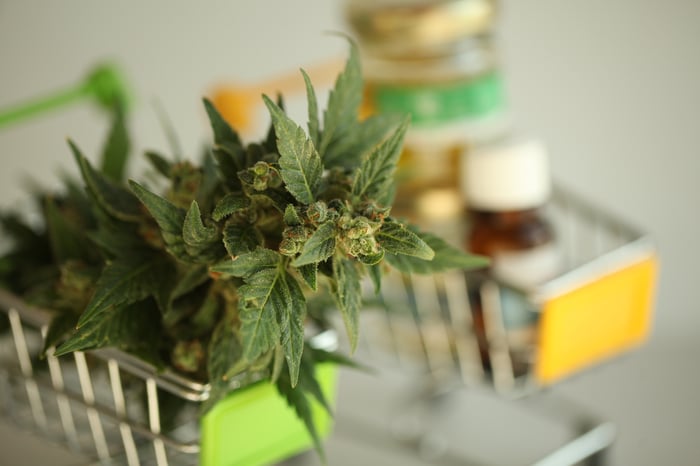There's no denying that the North American cannabis industry has incredible growth potential. But it's also no secret that the industry is encountering some serious speed bumps.
In our neighbor to the north, supply issues have plagued the marijuana markets pretty much since day one of recreational legalization (Oct. 17, 2018). Health Canada has been bogged down by applications for cultivation, processing, distribution, and sales licenses; at the same time, shortages of compliant packaging persist. Therefore, some growers are essentially biding their time on the sidelines until they're given the OK to begin producing cannabis, while others have marijuana at the ready, but no compliant packaging to get their product into legal weed stores.
Meanwhile, in the United States (or should I say California), a combination of supply issues and taxes have hurt sales. In the Golden State, the combination of state and local sales tax, the excise tax on marijuana sales, and the wholesale tax on cannabis leaves and/or flower can lead to an aggregate tax in some locales of up to 45% on legally bought pot. That's been more than enough to keep illicit producers in business, thereby curbing California's legal marijuana sales.

Image source: Getty Images.
Although many of these early problems can be worked through, some of the most popular pot stocks are expected to suffer as a result. Whereas most cannabis stocks will make the move to profitability in 2020, the following three are still expected to lose money.
Canopy Growth
Maybe the greatest irony of all is the fact that the largest marijuana stock in the world by market cap might be the last of the major pure-play pot stocks to make money. According to Wall Street's consensus estimate, despite $775 million Canadian dollars ($584 million) in fiscal 2020 sales, Canopy Growth (CGC 1.28%) is liable to lose CA$0.48 per share.
The reason for Canopy's steep projected loss in 2020 ties into its desire to create infrastructure domestically and globally, to take advantage of legalization in key markets. For example, it anticipates spending quite a bit in perhaps a half-dozen U.S. states to construct or acquire hemp-processing infrastructure. This includes spending up to $150 million (those are U.S. dollars) in New York State after being awarded a hemp-processing license in mid-January. Having this infrastructure on U.S. soil will be as good as gold if and when the government changes its tune on marijuana at the federal level.
Canopy Growth has also been aggressive on the acquisition front -- it acquired Colorado-based cannabis and hemp intellectual-property company ebbu for $310 million in November -- and has not been shy about spending on marketing, brand building, and product diversification. Despite having what's arguably the most recognizable pot brand throughout all of Canada in Tweed, Canopy is going to have to spend liberally to maintain what competitive advantages currently exist.

Image source: GW Pharmaceuticals.
GW Pharmaceuticals
Likewise, the largest pure-play cannabinoid drugmaker is also expected to produce sizable losses in 2020 -- albeit the magnitude of the loss next year should shrink considerably from 2019. Based on Wall Street's consensus, GW Pharmaceuticals (GWPH) could lose $2.34 per share in 2020.
The allure of GW Pharmaceuticals is the June 2018 Food and Drug Administration approval of lead drug Epidiolex as a treatment for two rare forms of childhood-onset epilepsy. The cannabidiol-based oral solution dazzled in multiple late-stage trials where, on average, it led to a reduction in seizure frequency from baseline of 30% to 40%, and it also handily outperformed the placebo it was tested against.
Cannabidiol (CBD) is the popular nonpsychoactive cannabinoid best known for its perceived medical benefits. More important, one of the two indications for Epidiolex, Dravet syndrome, previously had no FDA-approved treatments, meaning the drug has a currently clear runway to a rapid increase in sales.
But as is often the case with drug developers, there are exorbitant costs that go into researching and developing new therapies. Running clinical trials, in-lab research, angling for label expansion opportunities, and even filing for a new drug approval costs a lot of money. Add in marketing and stockpiling expenses, and it's not surprising in the least that GW Pharmaceuticals is slated to lose money in 2020.
The big question will be whether or not Zogenix's Fintepla -- a direct competitor to Epidiolex that was dealt a recent setback by the FDA -- continues to lag, or if it makes it to market in 2020 after satisfying the FDA's concerns. This will have major bearing on GW Pharmaceuticals' chances at profitability by 2021.

Image source: Getty Images.
MedMen Enterprises
Finally, popular multistate dispensary model MedMen Enterprises (MMNFF) is projected by Wall Street to lose $0.02 per share in 2020, despite the fact that sales could grow to $472 million, up from less than $40 million in 2018.
Similar to Canopy Growth and its lofty spending to move into new foreign markets, MedMen is having to spend liberally in order to build its brand in new U.S. states. Since marijuana is an illicit substance at the federal level, the transport of weed from one state to another, even if we're talking about two fully legal states, isn't allowed. That means vertically integrated dispensary models like MedMen need to construct grow farms and processing sites within the same states where they also sell cannabis. Of course, the reward of vertical integration is that it allows a retailer to internalize its costs, control the quality of its marijuana, and build a brand as it sees fit.
This year, MedMen plans to push heavily into Florida, and eventually it eyes having up to 30 dispensaries in the state, where medical marijuana is legal. It'll also be focused on closing its all-stock deal to acquire privately held PharmaCann for $682 million later this year. PharmaCann will double the number of states in which MedMen is licensed to 12.
Unfortunately, opening new stores and building grow farms isn't cheap. Making matters tougher, a significant portion of MedMen's existing revenue comes from California, where sales growth has slowed dramatically as the result of supply issues and a persistent black market. For the time being, and apparently into 2020, MedMen looks like it will lose money.





